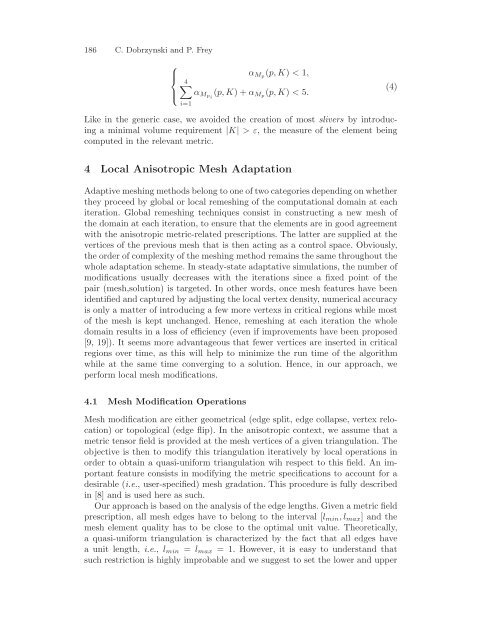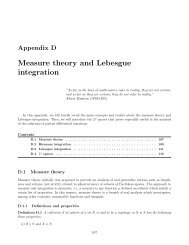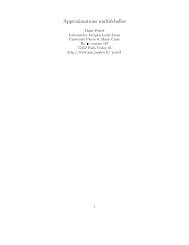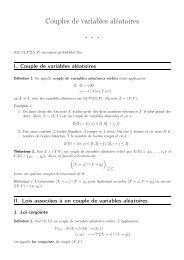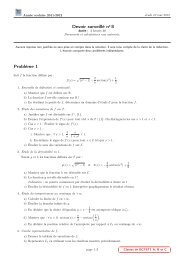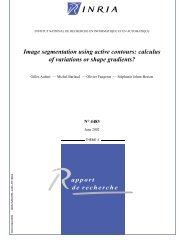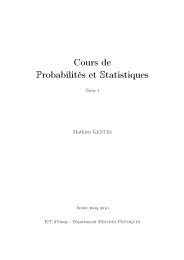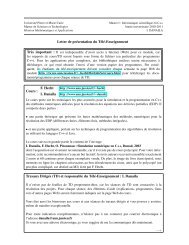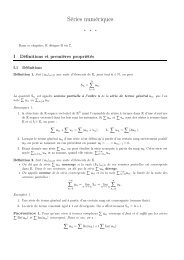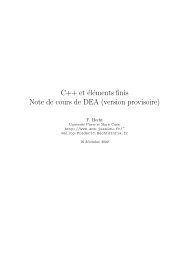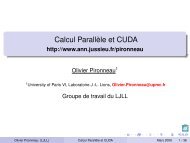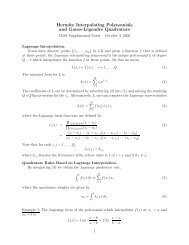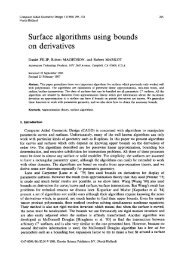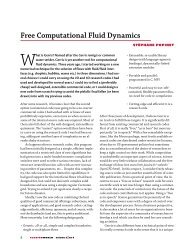Anisotropic Delaunay Mesh Adaptation for Unsteady Simulations
Anisotropic Delaunay Mesh Adaptation for Unsteady Simulations
Anisotropic Delaunay Mesh Adaptation for Unsteady Simulations
Create successful ePaper yourself
Turn your PDF publications into a flip-book with our unique Google optimized e-Paper software.
186 C. Dobrzynski and P. Frey<br />
⎧<br />
⎪⎨<br />
⎪⎩<br />
α Mp (p, K) < 1,<br />
4∑<br />
α Mpi (p, K)+α Mp (p, K) < 5.<br />
i=1<br />
(4)<br />
Like in the generic case, weavoided the creation of most slivers by introducing<br />
a minimal volume requirement |K| >ε, the measure of the element being<br />
computed in the relevant metric.<br />
4 Local <strong>Anisotropic</strong> <strong>Mesh</strong> <strong>Adaptation</strong><br />
Adaptive meshing methods belongto one oftwo categories depending on whether<br />
they proceed by global or local remeshing of the computational domain at each<br />
iteration. Global remeshing techniques consist in constructing anew mesh of<br />
the domain at each iteration, to ensure that the elements are in good agreement<br />
with the anisotropic metric-related prescriptions. The latter are supplied at the<br />
vertices of the previous mesh that is then acting as a control space. Obviously,<br />
the order of complexity of the meshing method remains the same throughout the<br />
whole adaptation scheme. In steady-state adaptative simulations, the number of<br />
modifications usually decreases with the iterations since a fixed point of the<br />
pair (mesh,solution) is targeted. In other words, once mesh features have been<br />
identified and captured by adjusting the local vertex density, numerical accuracy<br />
is only a matter of introducing a few more vertexs in critical regions while most<br />
of the mesh is kept unchanged. Hence, remeshing at each iteration the whole<br />
domain results in a loss of efficiency (even if improvements have been proposed<br />
[9, 19]). It seems more advantageous that fewer vertices are inserted in critical<br />
regions over time, as this will help to minimize the run time of the algorithm<br />
while at the same time converging to asolution. Hence, in our approach, we<br />
per<strong>for</strong>m local mesh modifications.<br />
4.1 <strong>Mesh</strong> Modification Operations<br />
<strong>Mesh</strong> modification are either geometrical (edge split, edge collapse, vertex relocation)<br />
or topological (edge flip). In the anisotropic context, we assume that a<br />
metric tensor field is provided at the mesh vertices of a given triangulation. The<br />
objective is then to modify this triangulation iteratively by local operations in<br />
order to obtain a quasi-uni<strong>for</strong>m triangulation wih respect to this field. An important<br />
feature consists in modifying the metric specifications to account <strong>for</strong> a<br />
desirable (i.e., user-specified) mesh gradation. This procedure is fully described<br />
in [8] and is used here as such.<br />
Our approach is based on the analysis of the edge lengths. Given a metric field<br />
prescription, all mesh edges have to belong to the interval [l min ,l max ] and the<br />
mesh element quality has to be close to the optimal unit value. Theoretically,<br />
a quasi-uni<strong>for</strong>m triangulation is characterized by the fact that all edges have<br />
aunit length, i.e., l min = l max = 1. However, it is easy to understand that<br />
such restriction is highly improbable and we suggest to set the lower and upper


